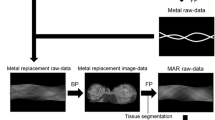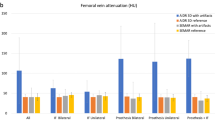Abstract
Purpose
To study the occurrence of orthopedic metallic hardware in routine abdomen/pelvic computed tomography (CT) scans and their impact on image quality (IQ) and diagnostic evaluation.
Material and methods
In this retrospective single institution study, we analyzed 3500 consecutive abdomen/pelvis CT scans for occurrence of orthopedic metallic hardware. In the cohort of patients with metallic hardware detected on CT scans, subjective and objective IQ analysis was performed to estimate diagnostic acceptability (DA, 4-point scale), subjective noise (SN, 3-point scale), presence of artifacts (PA, 4-point scale) and objective noise. The clinical significance of metallic hardware was determined by evaluating the impact of artifacts on radiological diagnosis according to the clinical indication and disease type.
Results
Orthopedic metallic hardware was encountered in 4.97% of abdomino-pelvic CT scans (n = 174/3500), and artifacts related to the hardware in the region of clinical interest were identified in 82% (n = 144/174) of scans. The overall mean DA was 2.66 (n = 174), and it was severely limited (score < 2) in 32% of cases particularly affecting patients with bilateral hip implants (92.6%, n = 25/27). The artifacts due to hardware significantly limited diagnostic evaluation in 58.6% of cases (PA score ≥ 3), and the image noise was unacceptable in 71% of cases (SN score > 2) in the region of clinical interest.
Conclusion
Orthopedic metallic hardware is encountered in nearly 5% of abdomino-pelvic CT scans and causes significant image degradation limiting diagnostic evaluation in the region of clinical interest.



Similar content being viewed by others
References
Maradit Kremers H, Larson DR, Crowson CS, et al. (2015) Prevalence of total hip and knee replacement in the United States. J Bone Jt Surg Am 97(17):1386–1397
Kurtz S, Ong K, Lau E, Mowat F, Halpern M (2007) Projections of primary and revision hip and knee arthroplasty in the United States from 2005 to 2030. J Bone Jt Surg Am 89(4):780–785
Ha AS, Petscavage-Thomas JM (2014) Imaging of current spinal hardware: lumbar spine. Am J Roentgenol 203(3):573–581
Rutherford EE, Tarplett LJ, Davies EM, Harley JM, King LJ (2007) Lumbar spine fusion and stabilization: hardware, techniques, and imaging appearances. RadioGraphics 27(6):1737–1749
Eberhardt SC, Johnson JA, Parsons RB (2013) Oncology imaging in the abdomen and pelvis: where cancer hides. Abdom Imaging 38(4):647–671
Genovese EA, Fonio P, Floridi C, et al. (2013 Jul 15) Abdominal vascular emergencies: US and CT assessment. Crit Ultrasound J 5(Suppl 1):S10
Gore RM, Miller FH, Pereles FS, Yaghmai V, Berlin JW (2000) Helical CT in the evaluation of the acute abdomen. Am J Roentgenol 174(4):901–913
Rubin GD, Dake MD, Napel SA, McDonnell CH, Jeffrey RB (1993) Three-dimensional spiral CT angiography of the abdomen: initial clinical experience. Radiology 186(1):147–152
Rubin GD, Shiau MC, Schmidt AJ, et al. (1999) Computed tomographic angiography: historical perspective and new state-of-the-art using multi detector-row helical computed tomography. J Comput Assist Tomogr 23(Suppl 1):S83–S90
Stoker J, van Randen A, Laméris W, Boermeester MA (2009) Imaging patients with acute abdominal pain. Radiology 253(1):31–46
Soto JA, Anderson SW (2012) Multidetector CT of blunt abdominal trauma. Radiology 265(3):678–693
Gupta A, Subhas N, Primak AN, Nittka M, Liu K (2015) Metal artifact reduction: standard and advanced magnetic resonance and computed tomography techniques. Radiol Clin N Am 53(3):531–547
Lee M-J, Kim S, Lee S-A, et al. (2007) Overcoming artifacts from metallic orthopedic implants at high-field-strength MR imaging and multi-detector CT. RadioGraphics 27(3):791–803
Stradiotti P, Curti A, Castellazzi G, Zerbi A (2009) Metal-related artifacts in instrumented spine. Techniques for reducing artifacts in CT and MRI: state of the art. Eur Spine J 18(Suppl 1):102–108
O’Brien J, Baerlocher MO, Asch M, Myers A (2009) Role of radiology in geriatric care. Can Fam Physician 55(1):32–37
Kalva SP, Mueller PR (2008) Vascular imaging in the elderly. Radiol Clin 46(4):663–683
Hopper KD, Singapuri K, Finkel A (2000) Body CT and oncologic imaging. Radiology 215(1):27–40
Buckwalter KA, Parr JA, Choplin RH, Capello WN (2006) Multichannel CT imaging of orthopedic hardware and implants. Semin Musculoskelet Radiol 10(01):086–097
Kataoka ML, Hochman MG, Rodriguez EK, et al. (2010) A review of factors that affect artifact from metallic hardware on multi-row detector computed tomography. Curr Probl Diagn Radiol 39(4):125–136
Vande Berg B, Malghem J, Maldague B, Lecouvet F (2006) Multi-detector CT imaging in the postoperative orthopedic patient with metal hardware. Eur J Radiol 60(3):470–479
Roth TD, Maertz NA, Parr JA, Buckwalter KA, Choplin RH (2012) CT of the hip prosthesis: appearance of components, fixation, and complications. RadioGraphics 32(4):1089–1107
Brook OR, Gourtsoyianni S, Brook A, et al. (2012) Spectral CT with metal artifacts reduction software for improvement of tumor visibility in the vicinity of gold fiducial markers. Radiology 263(3):696–705
Han SC, Chung YE, Lee YH, et al. (2014) Metal artifact reduction software used with abdominopelvic dual-energy CT of patients with metal hip prostheses: assessment of image quality and clinical feasibility. Am J Roentgenol 203(4):788–795
Jeong S, Kim SH, Hwang EJ, et al. (2015) Usefulness of a metal artifact reduction algorithm for orthopedic implants in abdominal CT: phantom and clinical study results. Am J Roentgenol 204(2):307–317
Kidoh M, Utsunomiya D, Ikeda O, et al. (2016) Reduction of metallic coil artefacts in computed tomography body imaging: effects of a new single-energy metal artefact reduction algorithm. Eur Radiol 26(5):1378–1386
Kuchenbecker S, Faby S, Sawall S, Lell M, Kachelrieß M (2015) Dual energy CT: how well can pseudo-monochromatic imaging reduce metal artifacts? Med Phys 42(2):1023–1036
Pessis E, Campagna R, Sverzut J-M, et al. (2013) Virtual monochromatic spectral imaging with fast kilovoltage switching: reduction of metal artifacts at CT. RadioGraphics 33(2):573–583
European guidelines on quality criteria for computed tomography (Internet). http://www.drs.dk/guidelines/ct/quality/htmlindex.htm. Cited 10 Oct 2018
Deetjen A, Möllmann S, Conradi G, et al. (2007) Use of automatic exposure control in multislice computed tomography of the coronaries: comparison of 16-slice and 64-slice scanner data with conventional coronary angiography. Heart 93(9):1040
Nguyen-Nielsen M, Borre M (2016) Diagnostic and therapeutic strategies for prostate cancer. Semin Nucl Med 46(6):484–490
Haidukewych GJ (2012) Metastatic disease around the hip: maintaining quality of life. J Bone Jt Surg Br 94(11 Suppl A):22–25
Constans JP, de Divitiis E, Donzelli R, et al. (1983) Spinal metastases with neurological manifestations. Review of 600 cases. J Neurosurg 59(1):111–118
Achenbach S, Delgado V, Hausleiter J, et al. (2012) SCCT expert consensus document on computed tomography imaging before transcatheter aortic valve implantation (TAVI)/transcatheter aortic valve replacement (TAVR). J Cardiovasc Comput Tomogr 6(6):366–380
Kaza RK, Platt JF, Goodsitt MM, et al. (2014) Emerging techniques for dose optimization in abdominal CT. RadioGraphics 34(1):4–17
Bamberg F, Dierks A, Nikolaou K, et al. (2011) Metal artifact reduction by dual energy computed tomography using monoenergetic extrapolation. Eur Radiol 21(7):1424–1429
Author information
Authors and Affiliations
Corresponding author
Ethics declarations
Funding
There is no source of funding for this original article.
Conflict of interest
Vinit Baliyan, Hamed Kordbacheh, Amir H. Davarpanah, Amirhossein Mozafarry and Avinash Kambadakone declare that they have no conflict of interest. Dushyant V. Sahani received grant support for research activities from GE Healthcare, Advisory Board of Allena Pharmaceuticals, Royalties from Elsevier.
Ethical approval
This article does not contain any studies with human participants or animals performed by any of the authors.
Rights and permissions
About this article
Cite this article
Baliyan, V., Kordbacheh, H., Davarpanah, A.H. et al. Orthopedic metallic hardware in routine abdomino-pelvic CT scans: occurrence and clinical significance. Abdom Radiol 44, 1567–1574 (2019). https://doi.org/10.1007/s00261-018-1818-3
Published:
Issue Date:
DOI: https://doi.org/10.1007/s00261-018-1818-3




